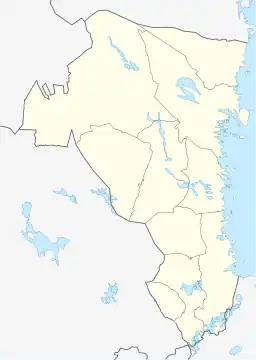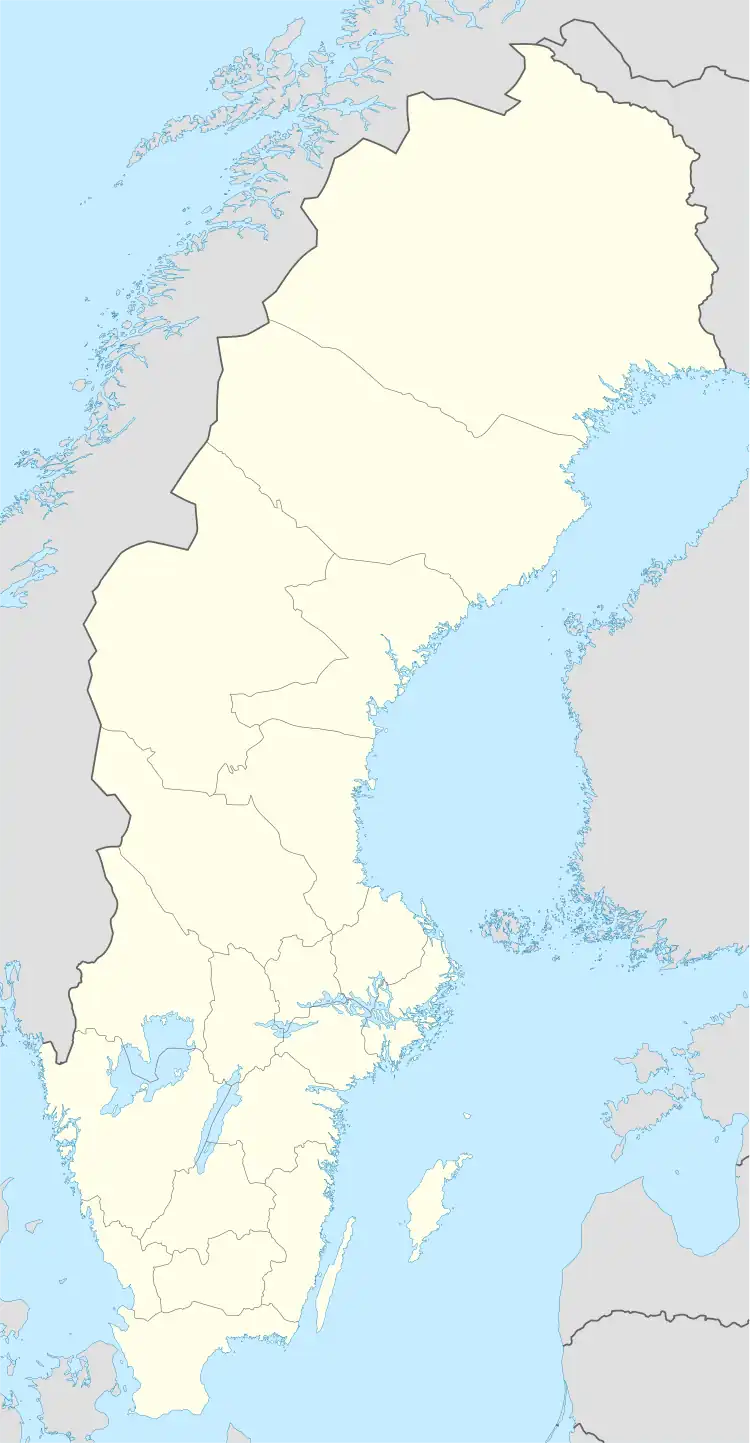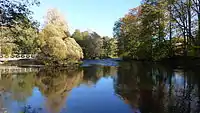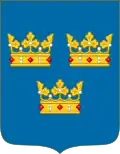Gävle | |
|---|---|
 Town square, Alderholmen, old town, the high-rise "Fullriggaren" at Gävle Strand, the town hall, buildings alongside the river of Gavleån | |
| Nickname: Gevalia | |
 Gävle Location of Gävle  Gävle Gävle (Sweden) | |
| Coordinates: 60°40′29″N 17°08′30″E / 60.67472°N 17.14167°E | |
| Country | |
| Province | Gästrikland |
| County | Gävleborg County |
| Municipality | Gävle Municipality |
| Area | |
| • City | 42.45 km2 (16.39 sq mi) |
| • Metro | 1,615.07 km2 (623.58 sq mi) |
| Elevation | 8 m (26 ft) |
| Population (2016)[2] | |
| • City | 75,451 |
| • Density | 1,673/km2 (4,330/sq mi) |
| • Urban | 96,969 |
| Time zone | UTC+1 (CET) |
| • Summer (DST) | UTC+2 (CEST) |
| Postal code | 80x xx |
| Area code | (+46) 26 |
| Website | www |
Gävle (/ˈjɛvleɪ/ YEV-lay, Swedish: [ˈjɛ̌ːvlɛ] ⓘ) is a city in Sweden, the seat of Gävle Municipality and the capital of Gävleborg County. It had 77,586 inhabitants in 2020,[3] which makes it the 13th-most-populated city in Sweden.[1] It is the oldest city in the historical Norrland (Sweden's Northern Lands), having received its charter in 1446 from Christopher of Bavaria. However, Gävle is far nearer to the greater Stockholm region than it is to most other major settlements in Norrland and has a much milder climate than associated with said region.
In recent years, the city has received much international attention due to its large Yule Goat figure made of straw - the Gävle Goat. The goat is erected in December each year and is often subsequently vandalized, usually by being set on fire. The goat has now become a symbol for the city and is being used for various marketing purposes.
History

It is believed that the name Gävle derives from the word gavel, meaning river banks in Old Swedish and referring to the Gavleån (Gävle River). The oldest settlement was called Gävle-ägarna, which means "Gavel-owners". This name was shortened to Gävle, then Gefle, and finally Gävle.
Gävle is first mentioned as a town in official history books in 1413 but only received its official town charters in 1446.[4]
For a long time, Gävle consisted solely of small, low, turf or shingle roofed wooden buildings. Boat-houses lined the banks of Gavleån, Lillån, and Islandsån. Until the 18th century the town was built, as was the practice then, around the three most important buildings: the church, the regional palace, and the town hall.
In the 1400s Gävle grew as a city and flourished due to trade allowed by its harbor and river. However, in the 1500s Sten Sture forbade Gävle from pursuing international trade. The city at this time was only allowed to trade with Stockholm and Åbo, which at the time was a part of Sweden. The restrictions were lifted in 1531 when 6 ships were allowed to trade iron, copper and pelts and in 1546 Gustaf Vasa allowed unlimited trade to and from Gävle with the exception of copper.[5]
In 1569 a fire destroyed many of the archaeological records of Gävle from the Middle Ages.[5]

Over the last 300 years, Gävle has been ablaze on three occasions. After the fire of 1776, the town was rebuilt with straight streets and rectangular city blocks. The number of stone and brick houses also started to increase. The biggest town fire occurred 1869, when out of a population of around 10,000 approximately 8,000 inhabitants lost their homes, and about 350 farms were destroyed. Almost the whole town north of Gavleån was burnt down. All the buildings south of Gavleån were saved. An area of the old town between the museum and the library has been preserved to this day as a historic reserve, Gamla Gefle.
After the catastrophe of the fire Gävle developed its characteristic grid plan with large esplanades and green areas. It is now a green town with wide avenues. Stopping the spread of future town fires was the main idea behind this development.
In July 1719 Hugo Hamilton, who built Fredriksskans fort, defended Gävle against Russian attacks. After attacking along the coast, the Russian forces, numbering 5000 and under the command of Peter von Lacy, attacked Gävle from the south along the road from Harnäs which they had recently occupied. Hamilton stopped them outside of the city near Järvsta.[6] The Russians instead tried to attack the city from the sea but the 10 cannon battery at Fredriksskans were sufficient to turn away their forces 3 times.[6] A final attempt was made to take the city by landing forces to the north at Engesberg. Hamilton quickly moved the defending forces northward to stop the attack.[7] On the 2nd of August von Lacy gave up and sailed homewards with his forces.
An extensive redevelopment of the central town area was started during the 1950s. Around 1970 Gävle became a large urban district when it was united with the nearby municipalities of Valbo, Hamrånge, Hedesunda, and Hille. New suburbs like Stigslund, Sätra, Andersberg, and Bomhus have grown up around the central city.
In the middle of the 1800s to the beginning of the 1900s, there was a bad harvest and a high unemployment rate in Sweden.[8] At the same time, political and religious oppression occurred, and religious encounters outside the State Church were not allowed. This led many Swedes to emigrate to other countries such as the United States. During the early emigration era, Gävle was one of the cities from which people left on their journey to the US. People from parts of Gästrikland and other neighboring counties made their way to the harbor town of Gävle and then commenced their departure to America.[9]

50,000 Russians who were in Germany at the outbreak of the First World War traveled up through Sweden to Gävle where they gathered at the harbor before setting off via steamboat back to Russia.[10]
The Harbor in Gävle was used for trade during the First World War and as a result some ships from Gävle were sunk during the German unrestricted submarine warfare campaign. One such example was the sailing vessel Jönköping, which was sunk on its way to Raumo from Gävle with a cargo of cognac and champagne for the Tsar.[10] A Finnish cargo vessel was sunk off the coast in Gävle.
In June 1945, 800 Soviet prisoners of war transited from Oslo to Gävle, whence they were transported aboard the boat Aldebaran across the Baltic Sea to the Soviet Union.[11]
In 1986 as a result of the Chernobyl disaster, Gävle was subjected to a severe deposition of radionuclides, exceeding 185 kBq per square meter. The impact was much greater than experienced by other regions of western Europe and as such, Gävle became one of the most affected areas outside of the Soviet Union.[12] Between 1905 and 1997, the I14 Regiment was located in Gävle.
In 2022 the City Library Building, constructed in 1962, was demolished to make room for a modern cultural center known as Agnes Kulturhus. During his jubilee visit to the city in 2023, King Carl XVI Gustaf toured the construction site of the cultural center and gifted it a plaque commemorating the visit and Time Capsule. As of October 2023 the Cultural Center is still under construction.[13][14]
Geography

Gävle is situated by the Baltic Sea near the mouth of the river Dalälven. At 60 degrees north and 17 degrees east, Gävle has the same latitude as Helsinki and the same longitude as Vienna and Cape Town. Bordering municipalities are Söderhamn, Ockelbo, Sandviken, Heby, Tierp and Älvkarleby. Twenty kilometers west of Gävle lies Sandviken.
Climate
Gävle has a similar climate to the rest of central Sweden with winter highs just below freezing and summer highs a bit above 20 °C (68 °F). The average yearly precipitation is around 600 mm (23.62 in). Under the Köppen climate classification Gävle is classified as humid continental (Dfb),[15] in spite of the significant maritime influence. It is also one of the northernmost cities of significant size in the world with this climate type, since areas north of the 60th latitude for the most part are dominated by various subarctic climate types. Under the 1961-1990 normals, Gävle's fourth warmest month was just around the isotherm of 10 °C (50 °F) to not be classified as subarctic, but temperatures did go up sufficiently to be clear humid continental since.
While precipitation usually is moderate, in August 2021, Gävle was hit by a Flash flood after recording 16 centimetres (6.3 in) of rainfall in one day.[16] Considerable flooding occurred in multiple regions with entire neighborhoods flooded. Vehicles were submerged and landslides occurred as well.[17][18][19] At least 10 heavy rain reports were reported.[20]
| Climate data for Gävle (2002–2021 averages; extremes since 1901) | |||||||||||||
|---|---|---|---|---|---|---|---|---|---|---|---|---|---|
| Month | Jan | Feb | Mar | Apr | May | Jun | Jul | Aug | Sep | Oct | Nov | Dec | Year |
| Record high °C (°F) | 11.0 (51.8) |
12.5 (54.5) |
18.3 (64.9) |
27.1 (80.8) |
28.9 (84.0) |
36.4 (97.5) |
34.4 (93.9) |
34.0 (93.2) |
28.0 (82.4) |
22.7 (72.9) |
15.0 (59.0) |
11.7 (53.1) |
36.4 (97.5) |
| Mean maximum °C (°F) | 6.2 (43.2) |
8.0 (46.4) |
13.6 (56.5) |
18.3 (64.9) |
24.0 (75.2) |
27.1 (80.8) |
28.8 (83.8) |
27.4 (81.3) |
22.9 (73.2) |
16.3 (61.3) |
11.2 (52.2) |
7.4 (45.3) |
29.8 (85.6) |
| Mean daily maximum °C (°F) | −0.4 (31.3) |
0.7 (33.3) |
4.7 (40.5) |
10.0 (50.0) |
15.1 (59.2) |
19.5 (67.1) |
22.2 (72.0) |
21.2 (70.2) |
16.6 (61.9) |
9.7 (49.5) |
4.5 (40.1) |
1.3 (34.3) |
10.4 (50.8) |
| Daily mean °C (°F) | −3.8 (25.2) |
−2.9 (26.8) |
0.2 (32.4) |
4.9 (40.8) |
9.7 (49.5) |
14.2 (57.6) |
16.7 (62.1) |
15.8 (60.4) |
11.7 (53.1) |
6.0 (42.8) |
1.9 (35.4) |
−1.5 (29.3) |
6.1 (42.9) |
| Mean daily minimum °C (°F) | −7.1 (19.2) |
−6.5 (20.3) |
−4.3 (24.3) |
−0.2 (31.6) |
4.2 (39.6) |
8.7 (47.7) |
11.2 (52.2) |
10.4 (50.7) |
6.8 (44.2) |
2.2 (36.0) |
−0.7 (30.7) |
−4.3 (24.3) |
1.7 (35.1) |
| Mean minimum °C (°F) | −20.1 (−4.2) |
−18.9 (−2.0) |
−14.7 (5.5) |
−6.3 (20.7) |
−2.6 (27.3) |
2.5 (36.5) |
5.0 (41.0) |
3.1 (37.6) |
−0.9 (30.4) |
−5.5 (22.1) |
−10.0 (14.0) |
−15.0 (5.0) |
−23.7 (−10.7) |
| Record low °C (°F) | −30.4 (−22.7) |
−33.7 (−28.7) |
−29.9 (−21.8) |
−17.9 (−0.2) |
−7.3 (18.9) |
−4.5 (23.9) |
1.0 (33.8) |
−2.2 (28.0) |
−5.7 (21.7) |
−15.1 (4.8) |
−22.5 (−8.5) |
−30.3 (−22.5) |
−33.7 (−28.7) |
| Average precipitation mm (inches) | 36.5 (1.44) |
26.8 (1.06) |
26.1 (1.03) |
23.1 (0.91) |
43.7 (1.72) |
67.2 (2.65) |
61.5 (2.42) |
92.7 (3.65) |
45.4 (1.79) |
67.2 (2.65) |
46.0 (1.81) |
40.7 (1.60) |
576.9 (22.73) |
| Average extreme snow depth cm (inches) | 31 (12) |
39 (15) |
31 (12) |
13 (5.1) |
0 (0) |
0 (0) |
0 (0) |
0 (0) |
0 (0) |
2 (0.8) |
10 (3.9) |
20 (7.9) |
47 (19) |
| Source 1: SMHI Open Data[21] | |||||||||||||
| Source 2: SMHI climate data 2002–2018[22] | |||||||||||||
Economy

Trade from the port of Gävle increased markedly during the 15th century when copper and iron began to be exported from the port. In order to ensure that all trade was via Stockholm, sailing to foreign ports from Gävle and a few other ports was forbidden.
During the 16th century, Gävle was one of the most important port and merchant towns with many shipping companies and shipyards.
In 1787 Gävle was awarded "free and unrestricted sailing rights" to and from foreign ports. This led to an increase in trade, which in turn led to an increase in buildings, industrial developments, trade and shipping.
From 1910-1979 Gefle Porslinfabrik produced porslin products. The factory, locally named 'Pottan' struggled during the First World War to get clay that would allow them to continue producing high quality products. Due to high transport and coal costs the factory had to raise the prices of their products by 40%.[23]
Today there are few shipping companies or shipyards left, but an important port remains. It has over 1000 ships calling per year and is among the top ten common ports in Sweden.
Major companies
- BillerudKorsnäs (pulp and paper industry)
- Jacobs Douwe Egberts S.E. AB (Gevalia coffee)
- Cale Industri (parking meters)
- Cibes Lifts (lifts for buildings)
Demography
Culture
Gävle has, considering its size, a large and well nourished cultural life, being a cradle for many musicians such as The Deer Tracks and The Sound of Arrows. The city applied to become the European Capital of Culture in 2014.

Arts and museums
The prison museum of Sweden, the county museum of Gävleborg, and the national railway museum are the three largest museums in the city. The prison museum is located near Gävle Castle and depicts the history of crime and punishment in Sweden. The county museum (located downtown) hosts an art collection spanning from the 1600s to present time and well as a section dedicated to cultural history. Finally, the Swedish Railway Museum (Rälsgatan 1), hosts a collection that began to accumulate in 1906 in Stockholm and which was moved to Gävle in 1970.
Gävle has a theater dating back to the 1800s. It is still used for performances today, including classic theater, opera, variety and stand-up.
There is also a concert hall in Gävle which was inaugurated in 1998. It is home to the 1912 Gävle Symphony Orchestra, whose principal conductor is Jaime Martín.

Media
Gefle Dagblad founded in 1895[24] and Arbetarbladet are the two leading media outlets covering Gävle in the papers. Both have a long history dating back to the early 1900s and the late 1800s, respectively. Aside from this, the Swedish national public TV broadcaster, SVT, has an editorial office in the city and the national public radio Sveriges Radio broadcasts from the city.
Sports
Gävle has teams competing in the highest national league in football (Gefle IF) as well as ice hockey (Brynäs IF) and floorball (Gävle GIK).
|
Speed skating
|
|
|

Å-Draget
Each September Gävle Kommun organises a weekend where outdoor candles are lit along the banks of the Gavle River in an attempt to highlight its beauty and its importance to the city.[25] The kommun organises different performances and activities for residents and visitors to enjoy as the walk along the river.[26]
Education
The University College of Gävle currently enrolls 16,000 students.[27] It offers over 800 courses and around 50 degree programs in technology, social and natural sciences, and the humanities. Its research profiles are "Built Environment" ("Byggd miljö") and "Health in working life" ("Hälsofrämjande arbetsliv").[28] Some courses are offered in English and are taken by both international and Swedish students.
Miscellanea
Gävle is known for being the birthplace of the Gevalia coffee brand, which is produced by Kraft General Foods Scandinavia and exported around the globe. Gevalia is particularly popular in the Americas and produces dozens of unique flavored coffees for the United States that are not available to its customers in Europe. However, visitors who come to the factory in Gävle can sample many of the premium blends. (Gevalia is the Latin name for Gävle).
Other brands from Gävle include the throat lozenges Läkerol and the car-shaped sweets Ahlgrens Bilar.
Gävle preserves the memory of the Swedish-American labor activist and martyr Joel Emmanuel Hägglund, better known as Joe Hill, who was born there in 1879. The Hägglund family home still stands in Gävle at the address Nedre Bergsgatan 28, in Gamla Stan, the Old Town. As of 2011 it houses a museum and the Joe Hill-gården, which hosts cultural events.
Gävle goat

The history of the Gävle goat began in 1966. Stig Gavlén came up with the idea of placing a giant version of the traditional Swedish Christmas goat of straw in Slottstorget (Castle Square) in central Gävle. On 1 December the 13-metre tall, 7-metre long, 3 tonne goat was erected on the square. At midnight on New Year's Eve, the goat went up in flames. The goat has since had a history of being burnt almost every year, 2005 being the 22nd time it was burnt. Burning the goat is an illegal act and not welcomed by most citizens of Gävle, but undoubtedly this is what has made the goat famous. In 2006 the goat was covered in a flame-resistant coating to prevent arson, enabling the goat to remain standing throughout that winter. On December 27, 2015, the goat was burnt for the 28th time. In its 54-year history, the goat has been burnt down 38 times.
Notable people
.jpg.webp)



- Linn Ahlborg (born 1999) Swedish blogger and influencer
- Siri Andersson-Palmestav (1903–2002) writer and missionary.
- Anna Bartels (1869–1950), opera singer
- Alexandra Dahlström (born 1984) actress and film director.
- Thomas Di Leva (born 1963) singer and songwriter.
- John E. Forsgren (1816–1890) the first Mormon missionary to preach in Sweden
- Hans Forssell (1843–1901) historian and political writer.[29]
- Åke Fridell (1919–1985) a film actor.
- Erik Acharius (born 1757) botanist.
- Valborg Elisabeth Groning (1890-1970) circus princess
- Joe Hill (1879–1915) labour activist and songwriter
- Rolf Lassgård (born 1955) an actor in crime dramas.
- Regina Lund (born 1967) actress and singer.
- Åke Lundqvist (1936–2021) actor at Stockholm City Theatre
- Yat Malmgren (1916–2002) dancer and acting teacher at the Drama Centre London
- Andreas Rudman (1668–1708), pioneer Swedish American Lutheran minister.[30]
- Rikard Sjöblom (born 1982), musician with Gungfly, Beardfish & Big Big Train.
- Cat Stevens (born 1948) musician; his mother Ingrid Wickman was from Gävle, where he lived during his childhood
- Joakim Sundström (born 1965) sound editor, sound designer and musician
- Daniel Waluszewski (born 1982) novelist and children's author
- Erik Wickberg (1904–1996) former General of The Salvation Army & Chief of the Staff of The Salvation Army
- Lars-Åke Wilhelmsson (born 1958) fashion designer and drag artist.
Sports professionals
- Nicklas Bäckström (born 1987) ice hockey player for the Washington Capitals
- Christian Edstrom (born 1976) rally co-driver
- Anders Eklund (1957–2010) Olympic heavyweight boxer
- Peppe Femling (born 1992) biathlete and Olympic gold medallist
- Andreas Johnsson (born 1994) ice hockey player for the San Jose Sharks
- Calle Järnkrok (born 1991) ice hockey player for the Toronto Maple Leafs
- Ewa Laurance (born 1964) pool player
- Oskar Lindblom (born 1996) ice hockey player for the San Jose Sharks
- Anders Lindbäck (born 1988) ice hockey goaltender who has played for several NHL teams
- Elias Lindholm (born 1994) ice hockey player for the Calgary Flames
- Jacob Markström (born 1990) ice hockey player for the Calgary Flames
- Christian Djoos (born 1994) ice hockey player, won Stanley Cup in 2018.
- Felix Sandström (born 1997) ice hockey goaltender for the Philadelphia Flyers
- Jakob Silfverberg (born 1990) ice hockey player for the Anaheim Ducks.
European cooperation
Gävle is a member city of Eurotowns network.[31]
Hospital
Gävle Hospital has approximately 300 physicians, and serves an area of approximately 150.000 people.[32] It has a centre for clinical research in cooperation with Uppsala University.[33]
Twin towns – sister cities
See also
References
- Notes
- 1 2 "Kommuner i siffror". Statistics Sweden. 22 April 2018. Archived from the original on 11 December 2016.
- ↑ Statistik Databasen
- ↑ "Statistiska tätorter 2018; befolkning, landareal, befolkningstäthet". 2021.
- ↑ "Gävle stads privilegier - Gefle från A till Ö" (in Swedish). www.gd.se. 2012-09-10. Archived from the original on 2013-06-25. Retrieved 2013-03-26.
- 1 2 Sterner, Jan (1999). Tvåtusen år i Gävlebygden (in Swedish). Knights Förlog. p. 65. ISBN 91-973608-1-3.
- 1 2 "När ryssen härjade nästan ända till Gävle". Gefle Dagblad (in Swedish). 7 August 2013. Retrieved 2023-03-25.
- ↑ "När ryssen härjade nästan ända till Gävle". Gefle Dagblad (in Swedish). 7 August 2013. Retrieved 2023-03-25.
- ↑ "Perspektiv på Historien", Nyström Hans, Nyström Lars, Nyström Örjan, 2011
- ↑ "Ett land likt himmelriket… Emigrationen via Gävle till Nordamerika vid mitten av 1800-talet", Severin, Göran, 1996
- 1 2 "Gävleborg i första världskrigets skugga". digitaltmuseum.se (in Swedish). Retrieved 2023-04-12.
- ↑ "Svenska Dagbladets historiska arkiv". Svenska Dagbladet (in Swedish). ISSN 1101-2412. Retrieved 2023-03-25.
- ↑ "Chapter II the release, dispersion and deposition of radionuclides". Chernobyl: Assessment of Radiological and Health Impact. Nuclear Energy Agency.
- ↑ [[:sv:Gävle stadsbibliotek|]] on the Swedish Wikipedia
- ↑ "Kungaparet besöker Gävle den 21 augusti" [The royal couple will visit Gävle on 21 August]. Cit of Gävle. February 2023. Retrieved 3 December 2023.
- ↑ "Gavle, Sweden Climate Summary". Weatherbase. Retrieved 25 March 2015.
- ↑ "Rekordstora dygnsnederbördsmängder" (in Swedish). SMHI. 19 August 2021. Retrieved 19 August 2021.
- ↑ Kraftiga skyfall och stora översvämningar i Gävle
- ↑ Vilde billeder fra Sverige
- ↑ Förödelsen dagen efter skyfallet i Gävle
- ↑ "European Severe Weather Database". Archived from the original on 2022-11-10.
- ↑ "SMHI Öppen Data nederbörd för Gävle A" [SMHI Open Data precipitation for Gävle A] (in Swedish). Swedish Meteorological and Hydrological Institute. Archived from the original on 2019-04-11. Retrieved 2019-05-21.
- ↑ "Statistik från Väder och Vatten" [Statistics from Weather and Water] (in Swedish). SMHI. 23 January 2022. Archived from the original on 2 May 2019. Retrieved 25 March 2015.
- ↑ "Stämplar och Signaturer - Gefle Porslinsfabrik". www.signaturer.se. Retrieved 2023-04-13.
- ↑ Gustafsson, Karl Erik. "Gefle Dagblad". www.ne.se. Nationalencyklopedin. Retrieved 11 September 2015.
- ↑ Interactive, Gestrike Media AB, Dreamscape. "Bra drag längs Gavleån". Gestrike Magasinet. Retrieved 2022-09-04.
{{cite web}}: CS1 maint: multiple names: authors list (link) - ↑ "Program Å-Draget 2022". Gävle kommun (in Swedish). Retrieved 2022-09-04.
- ↑ "About the University of Gävle". Archived from the original on 3 September 2011. Retrieved 21 December 2022.
- ↑ "Om Högskolan". www.hig.se. Retrieved 21 December 2022.
- ↑ Gosse, Edmund William (1911). . Encyclopædia Britannica. Vol. 10 (11th ed.). pp. 673–674.
- ↑ Andreas Rudman and his Family Archived 2009-11-15 at the Wayback Machine (by Peter Stebbins Craig. Swedish Colonial News, Volume 2, Number 1. Winter 2000)
- ↑ "Eurotowns – network of medium-sized cities". Eurotowns. Retrieved 21 December 2022.
- ↑ Gävle sjukhus at jobblanken.se, part of Internetmedicin. Updated 2012
- ↑ Centre for Clinical Research – Gävleborg (CFUG) Archived 2014-03-17 at the Wayback Machine from Uppsala University homepage > Medicine and Pharmacy > Centres. Updated: 11/29/2011.
- ↑ "Vänorter, partnerskap och nätverk". gavle.se. Archived from the original on 17 February 2015. Retrieved 26 April 2014.
- ↑ "Sadraudzības pilsētas". jurmala.lv. Archived from the original on 4 March 2016. Retrieved 26 April 2014. (in Latvian and English)
External links
 Gävle travel guide from Wikivoyage
Gävle travel guide from Wikivoyage- Gävle - official site
- Chisholm, Hugh, ed. (1911). . Encyclopædia Britannica. Vol. 11 (11th ed.). Cambridge University Press. p. 550.

